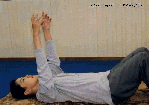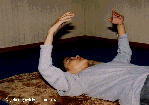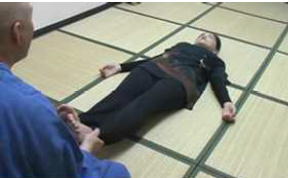- "A Butoh Dance Method for Psychosomatic Exploration"
(English/ French/ Polish)
A psychological paper of Memoir of H.I.T., published in March, 1999
The content is a basic training for enhancing psychosomatic awareness
based on Butoh Dance Method. Explanations of Takeuchi Lesson and Noguchi
Taiso (physical exercise) are included.
- "A Note on Butoh Body" (English/ French/ Polish)
A psychological paper of Memoir of H.I.T., published in March, 2000
Butoh body means a state of mind while performing Butoh although
the word 'body' is used. The multiplicity of our consciousness and a philosophical
idea 'non-objectification' are discussed in the paper in order to grasp the
essence of Butoh. Discussion on Internationalized Butoh is included.
- "Perception in Butoh Dance" (English/ French/ Polish)
A co-authored paper with Kate Parsons, an American philosopher, for Memoir
of H.I.T. Published in March, 2003.
Dance is usually thought to be a way of expression, but this is not
alwaysthe case in Butoh dance. 'Perception' and 'expression' is contrasted,
and it is shown that the dancer who 'perceives' the mind-body rather than
'expresses' the mind-body is engaged in dance that is more authentically
Butoh. The use of eyes is explained along with an analysis of Butoh's unique
stance against excessive use of visual perception.
- "Arm-Standing Exercise for Psychosomatic Training" (English/ )
A manual of how to carry out the arm-standing exercise for perceiving your arm weight well and enhancing your sensitivity of subtle muscle control, for Bulletin of Sapporo Gakuin University. Published in March,2005.
 while lying on your back while lying on your back 
This exercise has been pioneered by T.Kasai and Mika Takeuchi, a Japanese Butoh dancer, through Butoh dance workshops and day-care programs held at mental clinics. The extremely slow and elegant movements need sublte muscle control and mind-set in Butoh dance. The Arm-Standing Exercise, "ude-no-tachiage" exercise, one of 20-30 exercises utilized in their Butoh workshops, has been described fully in English with some practical suggestions.
This exercise has been cited in a newly published Butoh book "Hijikata and Ohno"(Routlege,2006) wirtten by Sondra Fraleigh and Tamah Nakamura.
Arm Standing Exercise was introduced in ECArTE conference on Sep.17, 2009 in London.
(European Consortium for Arts Therapies Education)
- [presentation and handout materials]
- "New understandings of Butoh Creation and Creative Aotopoietic Butoh
- From Subconscious Hidden Observer to Perturbation of Body-Mind System"(English /)
Bulletin of Faculty of Humanities, No.86, 21-36, 2009 Sapporo Gakuin University
(January, 2010)
Keywords:Butoh, autopoiesis, Hijikata, Ohno, performing art, creativity, psychosomatic, mirror neuron, somesthesia, dance therapy, posthypnotic suggestion, hidden observer, state bound memory, affordance, catastrophe, butterfly effect, chaos, perturbation, antagonistic movement, choreography, improvisation, primary process, individualization, Cartesian dichotomy
|



 "New Understandings of Butoh Creation and Creative Autopoietic Butoh
"New Understandings of Butoh Creation and Creative Autopoietic Butoh

